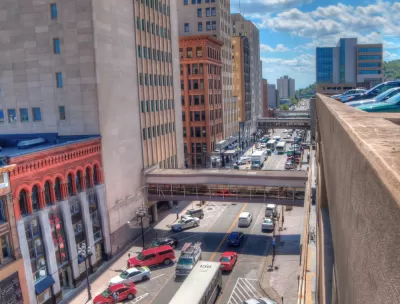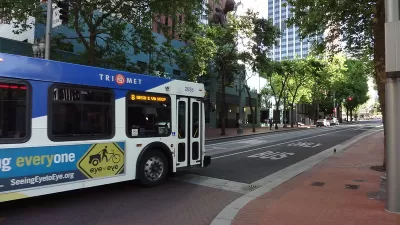The city of Duluth's reimagined bus transit system will go into effect in Summer 2022 along green and blue "Go Lines."

The Duluth News Tribune reports new details of the Duluth Transit Authority's (DTA) forthcoming high frequency bus routes, dubbed Go Lines.
Relying information announced in an unlinked press release from the DTA, the article explains that the new Go Lines are intended as "the backbone of DTA service," and will be distinguished from other transit service offered by DTA. In addition to 15-minute headways, Go Line routes will feature limited stops for express service and will go into effect next summer.
"The blue line will operate from Spirit Valley to downtown and on to the University of Minnesota Duluth by traveling on Grand Avenue, Superior Street and 21st Avenue East. The green line will operate from downtown to Miller Hill Mall and on to Walmart by traveling on Superior Street, Sixth Avenue East and Central Entrance," according to the article.
The article also notes that the DTA's remaining system will be pared from 33 routes, down to 14 simplified routes.
Planetizen picked up news of the city's plans to revamp its transit system in July 2021. The system changes implemented by Duluth embody a national trend toward redesigning bus systems around a high-frequency grid. The high frequency grid model is perhaps most famously exemplified by a system redesign completed by Houston in 2015.
FULL STORY: Duluth Transit Authority's 15-minute service dubbed 'Go Lines'

Alabama: Trump Terminates Settlements for Black Communities Harmed By Raw Sewage
Trump deemed the landmark civil rights agreement “illegal DEI and environmental justice policy.”

Planetizen Federal Action Tracker
A weekly monitor of how Trump’s orders and actions are impacting planners and planning in America.

The 120 Year Old Tiny Home Villages That Sheltered San Francisco’s Earthquake Refugees
More than a century ago, San Francisco mobilized to house thousands of residents displaced by the 1906 earthquake. Could their strategy offer a model for the present?

In Both Crashes and Crime, Public Transportation is Far Safer than Driving
Contrary to popular assumptions, public transportation has far lower crash and crime rates than automobile travel. For safer communities, improve and encourage transit travel.

Report: Zoning Reforms Should Complement Nashville’s Ambitious Transit Plan
Without reform, restrictive zoning codes will limit the impact of the city’s planned transit expansion and could exclude some of the residents who depend on transit the most.

Judge Orders Release of Frozen IRA, IIJA Funding
The decision is a victory for environmental groups who charged that freezing funds for critical infrastructure and disaster response programs caused “real and irreparable harm” to communities.
Urban Design for Planners 1: Software Tools
This six-course series explores essential urban design concepts using open source software and equips planners with the tools they need to participate fully in the urban design process.
Planning for Universal Design
Learn the tools for implementing Universal Design in planning regulations.
Clanton & Associates, Inc.
Jessamine County Fiscal Court
Institute for Housing and Urban Development Studies (IHS)
City of Grandview
Harvard GSD Executive Education
Toledo-Lucas County Plan Commissions
Salt Lake City
NYU Wagner Graduate School of Public Service





























